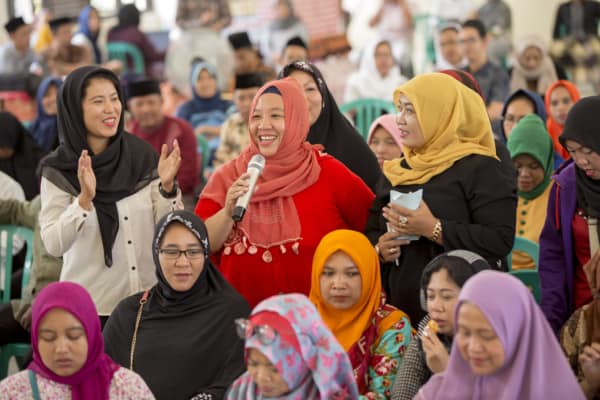Image: Sarah Schrauwen, Flickr.
Inclusion is the new buzzword in international development. The recently adopted Sustainable Development Goals are perhaps the most ambitious articulation of this consensus, with Goal 16 in particular calling for building more ‘effective, accountable and inclusive institutions at all levels’.
And there are good reasons for such emphasis: the evidence consistently shows that, over the long term, states and societies with more open and inclusive institutions, both political and economic, are more peaceful and more resilient, and tend to be better governed. However, this says little about how countries get there. I have been looking at processes of institutional transformation in Asia in an effort to help unravel this puzzle.
Asia’s political systems are extraordinarily diverse. Many are in the midst of complex processes of transformation across not just one but multiple dimensions of change, such as:
- from violent conflict towards peace;
- from exclusionary political orders to more open and inclusive ones;
- from a narrow and exclusionary sense of nation towards more inclusive nation-building;
- from personalised systems of interaction to ones that are more impersonal and grounded in the rule of law;
- from narrow-based economies towards shared growth.
Changes along some of these dimensions may reinforce one another. More often, however, they are likely to generate tensions and dilemmas and a need to compromise. So how do institutions that are more effective and inclusive emerge and evolve over time?
We know from historical experience that the “good governance” agenda embraced by the international development community since the 1990s is not likely to be the answer. Asia is a particularly compelling illustration: evidence from the region suggests that there is almost no correlation between development performance over the short to medium term and the World Bank’s Worldwide Governance Indicators. In effect, the World Bank’s newly launched World Development Report (WDR) 2017 on Governance and the Law provides a striking critique of an approach it once cherished.
So what factors have facilitated progressive institutional transformation? My analysis of Asia’s experiences highlights lessons that resonate with ongoing research and reflection in the field of politics and development.
Politics and power dynamics shape institutions and determine how and when development processes can become more inclusive. Policies matter, but where policies come from is even more important. This is also the central message emerging from the WDR 2017. This insight that politics matters is by no means new. However, it bears repeating since very often international efforts to foster more inclusive states and societies remain disconnected from the realities of how change happens.
The orientation and capacity of the state is essential in determining the prospects for more inclusive development – but this is not a technical issue. Rather, as the also WDR highlights, state effectiveness is fundamentally shaped by the role of and dynamics between competing elites, in ongoing interactions, bargaining and contestation with social forces from below. But states can be effective (for instance, in terms of their penetration or coercive capacities) without being concerned about either development or inclusion. As the case of Asia suggests, elite commitment and political leadership, often based on a political vision anchored in a shared sense of national purpose, are also crucial elements of what works.
Development processes are not black and white. The Asian experience shows that binary distinctions between, for instance, democracy/non-democracy or the presence/absence of corruption are too stark to help us understand a country’s institutional arrangements and prospects for transformation. There will always be difficult trade-offs between equally compelling imperatives. For example, while elite capture of public resources in developing countries is generally condemned by the international community, rents can be an important informal institution providing stability and even redistribution in settings where formal institutions remain weak.
Political parties have played an instrumental role in shaping government incentives to adopt policies that can foster more or less inclusion. Their structure, organisation and strategy, as well as the context in which they operate and the nature of political competition, are all important in determining how effective they are at harnessing collective action towards inclusion or exclusion, and towards greater or lesser developmental aims.
Strategic coalition-building with well-placed actors and allies is essential to push for change. Unresolved processes of contestation and failed collaboration are some of the biggest constraints to promoting reform. Thus, how the politics of coalition-building play out has important implications for the prospects for inclusion.
International factors can also influence domestic incentives and dynamics of reform. During the Cold War, for example, when social mobilisation or contention took on especially threatening forms, foreign intervention proved essential in supporting the kinds of developmental and/or authoritarian regimes that emerged across Asia. China’s size, power and extraordinary developmental transformation, for its part, gives it immense influence throughout the region.
If the Asian experience teaches us anything, it is that there are no blueprints for change, and that multiple paths towards more inclusive states and societies are possible. This should be encouraging for international efforts to support institutional change more effectively. It suggests that there is room for flexibility in the short to medium term as countries seek to transform themselves in different ways, even if they are confronted with important institutional weaknesses.
What is needed is a more strategic approach that can help identify and prioritise the governance improvements that are most crucial at different stages to enable more inclusive development and political processes. This calls for a shift from “best practice”, based on idealised models of change, to a “good fit” that is based in contextual realities. The WDR’s emphasis of this very point suggests that this message is no longer as far-fetched as it once seemed – even if the real challenge remains how to put it into action.









